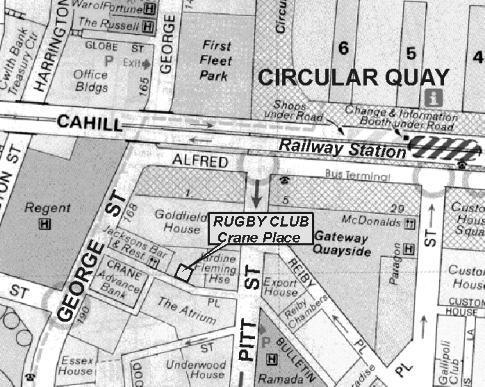
Rugby Club Location Map - Click to Enlarge
SMEDG - Notice of Meeting
Click here for this notice as a PDF document
DATE: Thursday 25th October 2001, 5.30pm for 6pm
VENUE: Rugby Club, Rugby Place, Circular Quay
SPEAKER: Steve Castor - Nevada Bureau of Mines and Geology
TOPIC: "Carlin-Type Gold Deposits - An Overview"
Nevada, with production of 8.6 million ounces of gold in 2000, is nearly as productive as Australia (9.5 million ounces). Most of Nevada's current gold production is from Carlin-type deposits. Extraction of gold from such deposits is generally considered a modern phenomenon, although regional production from Carlin-type ore preceded that at the Carlin Mine by as much as 70 years. Gold has been produced from more than 40 Carlin-type deposits in Nevada and Utah, but the northern Carlin trend, an area of about 4x35 km, accounts for 66 million of the 120 million ounces (production + reserves) estimated for all such deposits.
Carlin-type deposits are characterized by relatively high Au/Ag, enrichment in As, Sb, Hg, and Tl, and by the dominance of "invisible gold" as ions or submicron-sized particles in iron sulfide. The deposits are generally but not always hosted by Paleozoic carbonate rocks, and it has been proposed that they are largely controlled by deep-seated, ancient structures. Recent research indicates formation from relatively low temperature (150-250(C), low pH, and low- to moderately-saline fluids of mixed meteoric and magmatic or metamorphic origin. The age of ore deposition has been a matter of some speculation, but new data constrains most Carlin-type mineralization in north-central Nevada, site of more than 98% of Carlin-type ore, to the late Eocene, suggesting a genetic relationship with coeval regional magmatism. This has provided ammunition for the magmatist crowd; however, some researchers continue to advocate an amagmatic origin.
University of Nevada - Mackay School of Mines

Rugby Club Location Map - Click to Enlarge